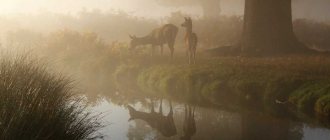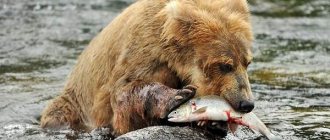Polar bears have many different names. They are called white because of the color of their fur, but there are other names for this species - northern bears, polar bears. Polar bears are close relatives of ordinary brown bears, although they differ from them in size and habits.
The northern bear is a very large animal. The body length of such a bear from nose to tail exceeds the height of an ordinary person and can reach 3 meters. The weight of the animal is much greater than that of a human: males grow up to tons in weight, and females up to 300 kg.
What color is a polar bear?
This question may seem strange, but the answer to it is no less surprising. It is generally accepted that the polar bear’s fur is exactly the same color as we see it – white. However, everything is not so simple. The skin of a polar bear under its fur is black, and the hairs covering its body are translucent and have no color of their own. The white color that we see when looking at a northern bear is just a play of light in a huge accumulation of hairs. Inside, each hair is hollow, like a cocktail straw.
What does it eat?
It is well established that “the bear greatly prefers honey.” For this treat, he is able to climb a very high tree. Fighting with the bees, the animal extracts honeycombs from the hollow and absorbs honey. However, the bear is more afraid of people than unbridled bees. But in general, this predator is undemanding: the bear also eats plant and animal foods. In the daytime he hides, in the evening he looks for food and hunts. We can say that the brown bear is omnivorous, but its menu is about 3/4 vegetable: berries, clubs, nuts, roots, stems and herbs. Its menu also includes insects (ants, lepidoptera), worms, lizards, frogs, rodents (mice, marmots, gophers, chipmunks), and fish. In autumn, the brown bear quickly prepares for winter - it eats clubs, nuts, wild apples, pears, mulberries, and cherries.
What are the characteristics of a polar bear?
The bear is very agile both in water and on land. Its body is ideally suited for living in ice. In addition to its camouflage white color, nature gave it an impressive layer of fat under its skin, which warms the northern bear in the cold. The polar bear has well-developed hearing, vision and sense of smell.
Unlike bears living in warm climates, polar bears have fur on the underside of their paws, which allows the bears to avoid freezing while constantly moving on the ice. At the same time, the fur on the front of the paws is tougher than in other places, because of this the bear confidently walks on the most slippery ice floes.
The polar bear's paws are also adapted for swimming. It has special membranes between its toes and when the bear hunts in water, it uses its paws as flippers.
Polar bears are solitary animals. They do not live in flocks or pairs. The only exception is a mother bear with cubs. The cubs live with their mother until they are one and a half years old, and then begin an independent life.
The polar bear does not go into hibernation every year; usually females go to winter hibernation, awaiting the appearance of offspring.
Report on the topic “Polar Bear” Maria Buldakova
Report on the polar bear for children
The polar bear is one of the largest predators living on land. Its height at the withers (from the ground to the neck) is 1.5 m, the foot size is 30 cm in length and 25 in width; Male polar bears weigh 350-650 kg, some even more, females 175-300 kg. A bear lives 15-18 years.
Polar bears live in the Arctic - at the North Pole.
The color of the fur is from snow-white to yellowish, thanks to this the bear is almost invisible in the snow, but the polar bear’s skin is black, but it is not visible through the thick fur, except very slightly on the nose. Polar bears are very resilient and can cover long distances at a brisk pace. Their feet are covered with fur, which gives them greater stability when moving on ice and snow. Polar bears can run, but they usually walk.
Polar bears are excellent swimmers; they jump into the water head first or slide off an ice floe, and swim using their front paws. They dive with closed nostrils and open eyes. They know how to fish. After coming ashore, they immediately shake off the water.
Polar bears spend much of the year on ice-bound shores along the coast. As a rule, they hunt alone. They search for food both day and night. Polar bears hunt seals by lying in wait at holes through which the seals breathe air, or by approaching animals lying on the ice. Polar bears have a very sensitive sense of smell. They are able to smell seals lying in a shelter under the snow.
These animals are very curious and intelligent. While tracking a seal, a polar bear covers its black nose with its paw, blocks the prey's escape route, or even pretends to be an ice floe floating by. A bear can experience emotions from rage to joy: after a successful hunt and a hearty lunch, he sometimes begins to frolic like a kitten.
In winter, when there is severe frost and polar night, the bear can hibernate. The she-bear also lies down for the winter in an ice den along with her cubs. For five months she does not eat any food and at the same time feeds the born cubs, usually two, with milk. The cubs, covered with sparse whitish fur, are born helpless, blind and deaf, no larger in size than newborn kittens. Their length is 17-30 cm, and their weight is 500-700 g.
In summer, bears' food is more varied: small rodents, polar foxes, ducks and their eggs. Polar bears, like all other bears, can also eat plant foods: berries, mushrooms, mosses, herbs.
There are not very many polar bears left on earth and hunting for them is limited.
What does a polar bear eat?
The polar bear hunts both on land and in water. Often he watches for sea animals at the holes and pulls them out onto the ice as soon as they look out of the water.
In times of famine, the polar bear is able to feed on bird eggs, algae and carrion, and in human habitats it is not averse to stealing the remains of human food from the trash heap or stealing supplies from the warehouse of a polar expedition.
Despite the fact that the polar bear is listed in the Red Book, its numbers are not decreasing these days. Hunting of these animals is prohibited and scientists hope that in the future this species will no longer be endangered.
Why are the numbers of polar bears decreasing?
Scientists' forecasts regarding the polar bear population are extremely pessimistic. It is expected that by 2060 the number of animals will decrease significantly. It is believed that no more than a third of the current population will remain. Moreover, northern bears in some regions will most likely disappear altogether.
Why is this happening? There are several reasons:
- Massive reduction in the area of drifting ice.
The ice where polar bears live is melting due to global warming. Over the current decade, Arctic ice will decrease by more than 40%.
There are fewer of them, and they are retreating further and further from the coast. This leads to the fact that it is more difficult for mother bears to get to land (they give birth in dens). And the animals are starving, because there is very little food in deep water.
- Poachers.
Polar bears are very valuable prey. Despite the fact that you cannot hunt them (the ban has been in effect since 1956), high prices for skins make poaching a profitable activity.
- Human need for oil.
Like other animals of the North Pole, the polar bear suffers the most not because of the mining of the mentioned minerals. The greatest danger is posed by an imperfect resource transportation system.
Tankers crash and oil ends up leaking into the water. A thin film destroys bottom vegetation, fish and other creatures that live in the seas. Once oil gets on bear fur, it changes its thermal insulation properties - the animals freeze.
- Pollution of the Arctic region.
It is not only oil that reduces the quality of the waters surrounding the Arctic. In one way or another, a lot of other harmful substances get into them, among which the greatest danger is:
- Radioactive materials.
- Heavy metals, their salts and oxides.
- Pesticides.
- Waste fuels and lubricants.
These substances accumulate in the cells of all animals, including polar bears. And this, in turn, suppresses their immunity and endocrine system.
Why the number of polar bears in the world is decreasing: Nur.kz
Report Polar Bear
The polar bear is the largest predator on earth. He has a strong body, massive paws, an elongated muzzle and sharp teeth, with the help of which he easily hunts his prey. The animal has snow-white fur, this is its most important difference from other bears. Over time it may turn yellow. The cavity of the hairs is filled with air, this mechanism helps to retain heat.
Adult males and females are between 2 and 2.5 meters tall and weigh between 200 and 600 kilograms. Bear cubs are born very tiny, 30 centimeters in length and weighing 500 grams. Mom takes care of her children only for 2 years, then they leave the den and begin an independent, adult life.
Animals live a long time, their average age is 20-30 years. A long-living polar bear is 45 years old.
Polar bears live in polar regions, where it is almost always cold. Therefore, their main habitat is sea ice. They eat fish that they catch under the ice. They hunt seals, sea urchins, and eat dead animals that have washed up on the shore.
When summer comes, the diet of polar bears becomes modest. They eat berries, bird eggs and chicks themselves, and catch fish. During such a hungry period, the animal is able to lose about half of its weight. Polar bears are not afraid of people, so they can settle near their habitats. In the summer, they penetrate human dwellings and feast on meat and fish.
In winter, bears go into hibernation, but this is most common for pregnant females. Before falling asleep for a long time, the animal must provide itself with food and stock up on enough fat so that the body does not experience hunger during sleep. This period lasts from 50 to 80 days. During hibernation, a polar bear's heart beats less frequently and breathing becomes less frequent. This is necessary to ensure that the oxygen contained in the den is spent wisely, as well as to ensure that there are enough nutrients for the entire duration of sleep.
After hibernation, the polar bear emerges from the den thin and very hungry, so he goes in search of food. As soon as he feasts on the first prey, he will eventually regain the weight that he lost. And he will return to his big, big appearance.
Polar bears are observant towards humans, but are not at all aggressive. Only females with cubs can pose a danger, so it is better to avoid them.
Polar bears hunt in a special way. They watch their prey, wait, and then stun them with their huge paw. They grab the prey and drag it onto the ice. Another way is to turn over the ice floe, on which seals usually rest. Once in the water, they cannot resist the predator.
Polar bears are ready to breed at the age of 4-8 years. Moreover, females mature earlier than males. The gestation period lasts almost like in humans and is 8 months. A maximum of 4 cubs are born, unable to see for a month, and fed on their mother’s milk.
1st, 2nd, 3rd, 4th, 5th, 7th grade, the world around us
Popular message topics
- Skiing
The ski device was invented by people many years ago. They used them to travel long distances. Initially, skis were called snowshoes; they were popular among ancient hunters who used snowshoes to go after their prey. - The flute is a musical instrument.
Despite the fact that the flute is considered one of the ancient Russian instruments, its analogues exist among many other nations. Therefore, the Ukrainian “sopilka” can be considered a cousin of the Irish teen-whistle. - Pollution of the world's oceans
The surface of the globe can be divided into four parts, one of which is occupied by land, and the remaining three of the four are covered by water. These three parts of the earth's surface that are under water are conventionally considered the world's oceans.





